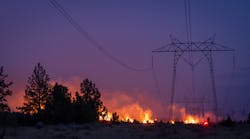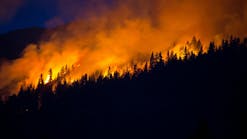From an electric utility perspective, wildfires used to be primarily a California problem, specifically Southern California. The 2018 Camp Fire — the deadliest and most destructive wildfire in California history, which began in Northern California’s Butte County — changed everything.
Not long afterward, during the 2020 wildfire season, Washington State — an annual leader in total rainfall — experienced the single largest 24-hour burn in its history, with over 300,000 acres (121,406 hectares) perishing as part of the Labor Day fires. And, in December 2021, massive wildfires destroyed more than 1000 homes in suburban Denver and Boulder.
After years of increasingly hot, dry weather and extended drought — part of the new normal of climate change — wildfires have emerged as an equal opportunity and omnipresent threat to a broader and broader swath of communities, and the utilities that serve them. In fact, some geographies no longer acknowledge a dividing line between wildfire season and the rest of the year, that is, a time of lower wildfire risk. Now, for some, every day is wildfire season. From a risk point of view — what every utility and grid operator is in the business of doing, managing risk — wildfire is now a top enterprise concern.
Risky Business
It is physically possible to avoid electric lines sparking wildfires and, in turn, keep wildfires from impeding the flow of electricity to consumers. It would just take drastic measures, like undergrounding most of the grid, and even a measure like this is no guarantee. Of course, utilities can’t really do that at this time. The cost would be too extreme, and cost is one of the big variables in all risk management calculations.
Additionally, as costly, terrifying and devastating as wildfires are, they are only one variable in a utility’s overall risk and operating calculations. Conceptually, massive amounts of utility funding could be directed at solving the wildfire problem, but utilities have other expensive challenges to meet and opportunities to fulfill.
Most investor-owned utilities have gone on the record with aggressive carbon reduction goals. The COVID-19 pandemic exposed and exacerbated equity fault lines. Extreme weather threatens the grid at every turn. Fixing all these problems and getting the balance right to create the sustainable utility — a more environmentally friendly, safe and reliable, affordable and, yes, profitable utility — that creates opportunities for all its stakeholders requires smart investment across a swath of simultaneously pressing concerns, and all against a backdrop of downward cost pressure.
That is why so much hinges on risk management and why breakthroughs in wildfire-risk mitigation may lead to a wholesale change — and radical improvement — in how utilities look at all their risk and investment opportunity moving forward.
Data Driven
Most utilities share a common approach to wildfire-risk mitigation, and it is a logical one: They start with what they know.
For example, they map out their physical infrastructure and assess where along the routes are the greatest population and fuel (that is, vegetation) densities. For the probability component of risk, they might superimpose on that map historical outages, tree encroachment and fire history data — along with some internal data analytics — to develop a broad overview of fire probability risk across their service territory, perhaps attributing a probability risk score to each area on the map.
While this is a good first step, it immediately brings into focus the limitations of legacy risk approaches and the weakness of some of their underlying assumptions. It can be frustrating for a utility trying to improve the performance of its worst-performing circuits — especially when investing in them heavily year after year and the circuits continue to disappoint.
The utility’s guiding assumptions may be wrong. The circuits cannot be fixed just by throwing traditional grid investments at the problem. Great risk management does not mean finding the worst-performing circuits and pumping money into them. Instead, it means using data differently to identify where investing in the grid would make the biggest positive impact.
Mitigating wildfires is going to require a data-driven approach, one that can effectively predict the probability and impact of wildfires and enable utilities to zero in on where every dollar invested — in grid hardening, proactive shutdowns, tree trimming and removals, meteorology and inspections — will deliver the biggest bang for the buck in terms of increased safety and reliability.
A Digital Replica
Utilities must move from a broad view of fire hazard — for example, 50% of its service territory is in some form of an elevated fire-risk zone — to driving performance improvements relative to data-driven expectations. Or, put another way, how do utilities move from identifying wildfire risk to deciding what to do about it?
The way to do that is by getting granular. And, the way to do that in 2022 is by building a digital replica of the entire system — and populating it byte by byte with data.
The good news is utilities already generate and store a lot of data: customer information, billing, system data, outage data, inventory and costing. All of it, right down to the height and composition of a pole, size of a conductor and maintenance history, will enhance the accuracy of the digital replica on which machine learning and data science will work to model and optimize wildfire — and, importantly, all safety and reliability — risk.
This vast pool of data is the fuel artificial intelligence uses to dig deeper, but it is only the tip of the iceberg. Reams of third-party data essential to understanding wildfire risk and spread are available to refine the digital replica, and the risk models run upon it: data on weather, moisture, elevation, slope, wind speed, vegetation density and lightning strikes.
Instead of a simple map identifying zones of highest risk, imagine a living model of the system that includes those first simple inputs but also all the additional historical and real-time information further enhanced by satellite and light detection and ranging (LiDAR) imagery. And, that is when the game starts to change. Ten year or even five years ago, this was not possible. Today, there is more data, more ability to augment data, and more cloud-based processing power and advanced machine learning than ever, giving utilities a long-sought-after advantage in their ongoing risk analyses.
Now, because of these advancements, utilities can model what the grid looks like as well as predict its future performance. Meaningfully, the delta between that expected performance and actual system results then becomes the target for further optimization. That is where every dollar invested can drive the greatest return.
Risk Tolerance
This digital replica, this living, granular model has many benefits to managing and mitigating wildfire risk. First, it helps utilities identify what risk looks like circuit by circuit, which is genuinely useful. However, not all parts of a circuit are created equal. Some parts are higher risk — because of vegetation and exposure — than others, and that is where the ability to zoom into the data at the sub-circuit level, right down to each 500-m (1640-ft) stretch, can help utilities to understand risk with more precision than ever possible.
Utilities used to have to settle for big-bucket approaches to risk. Now, they can analyze it meter by meter in hyper granularity, modeling the impact of every dollar spent to harden the grid. The approach is not unlike a financial advisor optimizing a retirement portfolio based on an individual’s risk threshold.
With a known budget and risk tolerance, utilities can approach wildfire risk mitigation in one of two ways. Keeping budget a constant, they can use the model to improve safety and reliability by asking where additional vegetation management work, upgrading conductor size, introducing concrete poles, and initiating more clearance work around poles will make the biggest safety and reliability impact. Conversely, utilities can say, “I have a particular risk I am willing to absorb,” and work the data-driven model to optimize the cost — and the result — of the same grid-hardening tactics. Two dials: One optimizing safety and reliability for a given budget, and the other optimizing spend for a given safety and reliability target.
Enormous Potential
This risk approach, using a living digital replica of the grid and data-driven models, holds enormous potential not just in wildfire mitigation but across the spectrum of grid investments utilities must make to address their many competing needs and opportunities. With this foundational risk management element in place, a new era of risk-spend efficiency at utilities will enable them to maximize their return on every dollar spent by knowing the impact each dollar will have on performance before making it.
The implications of knowing this will be far reaching. Utilities are used to being second guessed, of people not trusting their decisions. A data-driven approach will enable utilities to show their cards: “Here’s how we are proposing to spend X dollars to drive down risk.” If that budget meets resistance and 10% or 20% less is offered, the utility can show the exact impact of that decision on future safety and reliability, upping the ante on accountability.
Tom Martin is vice president of data science commercialization at E Source, where he leads the data science team and is a key partner in helping utility clients to understand the transformational role data science solutions can play in their operations. Prior to E Source, he served as managing director of data science at TROVE, and he led the implementation of new technology and analytics at Pacific Gas and Electric Co. to reduce the utility’s operational costs, improve safety and increase grid reliability.


